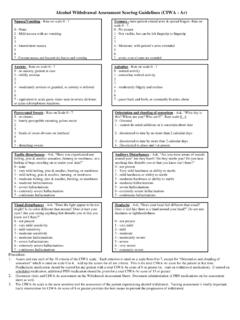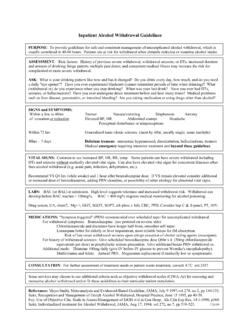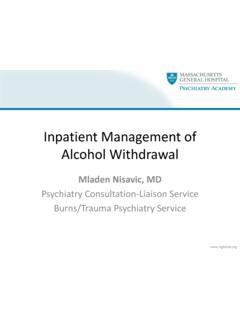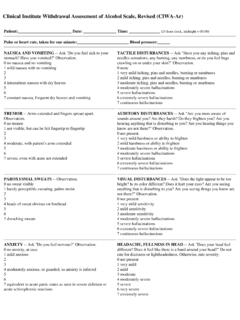Transcription of Management of Withdrawal: Alcohol, Benzodiazepines, Opioids
1 Management of Withdrawal: Alcohol, Benzodiazepines, Opioids Julie Kmiec, DO. University of Pittsburgh AOAAM 2018 1. Objectives Name common signs and symptoms of alcohol, benzodiazepine, and opioid withdrawal Discuss evidence-based treatment of alcohol, benzodiazepine, and opioid withdrawal 2. ALCOHOL. 3. Alcohol Tolerance Ordinarily, excitatory (glutamate) and inhibitory (GABA). neurotransmitters are in homeostasis Alcohol facilitates GABAA neurotransmission Over time, repeated use of alcohol causes a decrease in the number of GABA receptors (down regulation) and more alcohol is needed to produce effect 4. Attempt to Regain Homeostasis Alcohol acts as an NMDA receptor antagonist, which decreases excitatory tone Chronic alcohol use leads to upregulation of NMDA receptors and more glutamate production 5. Withdrawal If alcohol is stopped suddenly, the inhibition from alcohol is reduced, and the glutamate related excitation is unopposed This results in symptoms of alcohol withdrawal During alcohol use and withdrawal there is an increase in dopamine which contributes to autonomic hyperarousal and hallucinations 6.
2 Alcohol Withdrawal Onset of particular symptoms Withdrawal 6-24 hrs after last drink, peaks 24-36 hrs Seizures 6-48 hrs after last drink, peak at 24 hrs Withdrawal Delirium (aka delirium tremens, DTs). 48-96 hrs after last drink 7. Signs & Symptoms of Withdrawal Signs Symptoms Elevated BP, HR, temp Anxiety Sweating Insomnia Tremor Vivid dreams Diaphoresis Headache Dilated pupils Loss of appetite Disoriented Nausea Seizure Irritability Hyperactive reflexes Insomnia Illusions/Hallucinations 8. Kattimani & Bharadwaj, 201310. Alcohol Withdrawal Seizures Withdrawal seizures begin 6-48 hrs after last drink, peak at 24 hrs May occur before BAL is zero Most are generalized seizures Partly genetic Increased in those with a history of withdrawal seizures Kindling effect more episodes of alcohol withdrawal, higher risk May occur in 10% of withdrawal patients About 30% with withdrawal seizure progress to delirium 11. Rogawski, 2005; Tovar, 2011.
3 Alcohol Withdrawal Hallucinosis Visual, auditory, tactile hallucinations Intact orientation Normal vital signs Hallucinations can last 24 hours to 6 days May occur in up to 25% of those who drink alcohol heavily 12. Tovar, Alcohol Withdrawal Delirium May begin 48 hours after last drink, last up to 2. weeks Tachycardia, hypertension, fever Tremor Diaphoresis Fever Confusion, disorientation Hallucinations Agitation Disruption of sleep-wake cycle 13. Death Tovar, 2011. CIWA-AR. (Sullivan et al., 1989). Study found P and BP. did not correlate with severity of withdrawal. Determined other signs and symptoms are more reliable in assessing severity of withdrawal Score range 0-67. Score <10. pharmacologic treatment not needed Alcohol Withdrawal Treatment Benzodiazepines still gold-standard for moderate to severe withdrawal Anticonvulsants gabapentin and carbamazepine have evidence for treating mild withdrawal (Minozzi et al., 2010).
4 Phenobarbital similar effectiveness to lorazepam (Hendey et al., 2011). 15. Alcohol Withdrawal Treatment: Adjuncts Haloperidol for agitation, confusion Thiamine Multivitamin Folic acid 16. Medications Typically Used for Alcohol Withdrawal Medication Typical Onset of Action Half-Life Metabolism Route of Admin. Chlordiazepoxide Oral 15-30 mins 5-30 hrs, Phase I & II. 200 hrs 3A4. 17. Lorazepam Oral, IV <15 mins (IV) 12-18 hrs Phase II. 15-30 mins (PO). Diazepam Oral, IV <15 mins 30-60 hrs, Phase I & II. 100 hrs 2C19, 3A4. Oxazepam Oral 30-60 mins 8-14 hrs Phase II. Considerations Active metabolites If several active metabolites drug has longer duration and withdrawal may be delayed Active metabolites may accumulate and cause confusion and falls, especially in Elderly People with liver disease May interact with other medications 18. Medication Regimens Taper Give tapering dose of medication at scheduled intervals Chlordiazepoxide 50 mg q6h x4 doses, then 25 mg q6h x8 doses Diazepam 10 mg q6h x4 doses, then 5 mg q6h x8 doses Lorazepam 2 mg q6h x4 doses, then 1 mg q6h x8 doses Monitor between dosing intervals on CIWA and provide additional medication if score >8-10.
5 19. Mayo-Smith et al., 1997. Medication Regimens Symptom triggered treatment Only medicate when score above a certain threshold on Clinical Institute Withdrawal Assessment (CIWA). 20. Symptom Triggered Dosing CIWA-Ar Score If score >10 give lorazepam 1 mg or chlordiazepoxide 25 mg If score >20 give lorazepam 2 mg or chlordiazepoxide 50 mg Monitor patient every 4-8 hrs with CIWA-Ar until score has been <8-10 for 24 hours Withdrawal scales are not a substitute for clinical judgment 21. Examples when taper may be treatment of choice Busy unit where patient will not be monitored closely to ensure he/she is given medication for withdrawal regularly Patient has a history of complicated withdrawal If symptoms triggered dosing is not adequate ( , continuing high scores on CIWA). 22. Evidence for Medication Regimens In alcohol withdrawal, those receiving symptom triggered treatment received less medication had shorter length of treatment shorter hospital stay compared to those receiving medications on fixed schedule Daeppen JB, Gache P, Landry U, Sekera E, Schweizer V, Gloor S, Yersin B.
6 Symptom-triggered vs fixed-schedule doses of benzodiazepine for alcohol withdrawal: a randomized treatment trial. Arch Intern Med. 2002 May 27;162(10):1117-21. 23. Saitz R, Mayo-Smith MF, Roberts MS, Redmond HA, Bernard DR, Calkins DR. Individualized treatment for alcohol withdrawal. A. randomized double-blind controlled trial. JAMA. 1994 Aug 17;272(7):519-23. PubMed PMID: 8046805. Outpatient Detoxification Selection Patient is reliable and motivated to stop using alcohol and other substances medically and psychiatrically stable has social support transportation to appointments or ED if needed 24. Stability No medical problems that alone require hospitalization No medical problems that can be worsened by withdrawal No history of complicated withdrawal No history of withdrawal seizures, delirium, +/-hallucinosis Not suicidal or homicidal Vital signs stable or able to be stabilized Not pregnant 25. Pharmacotherapy Anti-cravings Acamprosate Naltrexone Deterrent Disulfiram Meds to treat comorbid disorders (depression, anxiety, insomnia).
7 26. BENZODIAZEPINES. 27. Benzodiazepine Withdrawal Withdrawal depends on the Dose Duration of use Duration of drug action Most likely to occur after discontinuation of A therapeutic daily dose used for 4-6 months A dose exceeding 2-3x the upper limit of therapeutic dose used for 2- 3 months Withdrawal begins 12-48 hours after last use, depending on drug used 28. Signs and Symptoms of Benzo Withdrawal Tachycardia, hypertension, fever, diaphoresis Agitation, anxiety, irritability Delirium, seizures Hallucinations (tactile, visual, auditory). Insomnia, nightmares Tremor, hyperreflexia Tinnitus, mydriasis, photosensitivity, hyperacusis Anorexia, nausea, diarrhea Death 29. Benzodiazepines Onset of Action Rapid (within 15 mins). Diazepam Lorazepam (IV, IM, SL). Intermediate (15-30 mins). Alprazolam Lorazepam (PO). Chlordiazepoxide Clonazepam Slow (30-60 mins). Oxazepam Drugs with a quicker off-set have higher potential for dependence due to need 30.
8 For repeated dosing Relative High When asked to rate the high from BZD in people who abuse BZDs Diazepam = #1. Lorazepam and alprazolam slightly, but not significantly, lower than diazepam Relative high was significantly less for oxazepam and chlordiazepoxide compared to diazepam, lorazepam, and alprazolam Preferred BZD in patients with BZD dependence Diazepam (43%), alprazolam (14%), chlordiazepoxide (4%), lorazepam (4%). 31. Griffiths RR, Wolf B. Relative abuse liability of different benzodiazepines in drug abusers. J Clin Psychopharmacol. 1990 Aug;10(4):237-43. Malcolm R, Brady KT, Johnston AL, Cunningham M. Types of benzodiazepines abused by chemically dependent inpatients. J Psychoactive Drugs. 1993 Oct-Dec;25(4):315-9. Benzodiazepine Withdrawal Withdrawal severity depends on the Dose Duration of drug action (half-life). Individual's characteristics Baseline depression and anxiety Personality traits ( , dependent). Lower education level Alcohol use Female Murphy SM, Tyrer P.
9 A double-blind comparison of the effects of gradual withdrawal of lorazepam, diazepam and bromazepam in benzodiazepine dependence. Br J Psychiatry. 1991 Apr;158:511-6. 32. Rickels K, Schweizer E, Case WG, Greenblatt DJ. Long-term therapeutic use of benzodiazepines. I. Effects of abrupt discontinuation. Arch Gen Psychiatry. 1990 Oct;47(10):899-907. Schweizer E, Rickels K, Case WG, Greenblatt DJ. Long-term therapeutic use of benzodiazepines. II. Effects of gradual taper. Arch Gen Psychiatry. 1990 Oct;47(10):908-15. Withdrawal By Half-life Short Half-Life Benzos Long Half-Life Benzos 33. Rickels K, Schweizer E, Case WG, Greenblatt DJ. Long-term therapeutic use of benzodiazepines. I. Effects of abrupt discontinuation. Arch Gen Psychiatry. 1990 Oct;47(10):899-907. Benzodiazepine Withdrawal Successful outcome depends predicted by Dose Lower dose Duration of drug use Shorter period of use Individual's characteristics Lower baseline anxiety 34.
10 Rickels K, DeMartinis N, Garc a-Espa a F, Greenblatt DJ, Mandos LA, Rynn M. Imipramine and buspirone in treatment of patients with generalized anxiety disorder who are discontinuing long-term benzodiazepine therapy. Am J Psychiatry. 2000 Dec;157(12):1973-9. Medications for Benzo Withdrawal Benzodiazepines Barbiturates Adjunctive medications for anxiety, depression, or insomnia Antipsychotic in cases of delirium 35. Medication Regimens Taper Give tapering dose of medication at scheduled intervals Also monitor between dosing intervals on CIWA. Symptom triggered treatment Only medicate when score above a certain threshold on CIWA. 36. 37. Sullivan JT, Sykora K, Schneiderman J, Naranjo CA, Sellers EM. Assessment of alcohol withdrawal: the revised clinical institute withdrawal assessment for alcohol scale (CIWA-Ar). Br J Addict. 1989 Nov;84(11):1353-7. Withdrawal Scales Benzodiazepine Withdrawal Symptom Questionnaire 20 items, scored 0-2.





